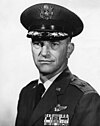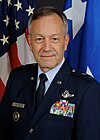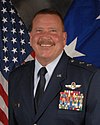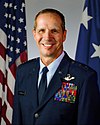Fourth Air Force
| Fourth Air Force | |
|---|---|
 Shield of the Fourth Air Force | |
| Active | 1 December 1985 - present (as Fourth Air Force) 24 September 1976 - 1 December 1985 (as Fourth Air Force (Reserve)) 20 January 1966 - 30 September 1969 18 September 1942 - 1 September 1960 (as Fourth Air Force) 26 March 1941 - 18 September 1942 (as 4 Air Force) 19 October 1940 - 26 March 1941 (as Southwest Air District) (84 years, 2 months)[1] |
| Country | |
| Branch | |
| Type | Numbered Air Force |
| Role | Provide combat-ready reserve air mobility and support forces[2] |
| Part of | |
| Headquarters | March Air Reserve Base, California, U.S. |
| Engagements | World War II – American Theater[1] |
| Decorations | Air Force Outstanding Unit Award |
| Website | www |
| Commanders | |
| Commander | Maj Gen Derin S. Durham |
| Vice Commander | Col Daniel J. Ebrecht |
| Command Chief | CCM Travon W. Dennis |
| Notable commanders | Carroll W. McColpin Benjamin H. King |
The Fourth Air Force (4 AF) is a numbered air force of the Air Force Reserve Command (AFRC). It is headquartered at March Air Reserve Base, California.
4 AF directs the activities and supervises the training of more than 30,000 Air Force Reservists. If called to active duty, 4 AF's ready reserve units would be assigned to Air Mobility Command, Air Education and Training Command, and Pacific Air Forces.[2] Several airfields are associated with the Fourth Air Force.
One of the four original pre–World War II numbered air forces, 4 AF was activated on 18 December 1940, at March Field, California with a mission of air defense of the Southwestern United States and Lower Midwest regions. During the war, its primary mission became the organization and training of combat units prior to their deployment to the overseas combat air forces.
4 AF is commanded by Major General Derin S. Durham.
Units
[edit]Fourth Air Force flying units include one unit-equipped air mobility and two unit-equipped airlift wings, five unit-equipped air refueling wings, three associate air mobility wings, two associate airlift wings and one associate air refueling wing.
- Headquarters, Fourth Air Force, March ARB, California
- 315th Airlift Wing, Joint Base Charleston, South Carolina
- 349th Air Mobility Wing, Travis AFB, California
- 433d Airlift Wing, Lackland AFB, Texas
- 434th Air Refueling Wing, Grissom ARB, Indiana
- 439th Airlift Wing, Westover ARB, Massachusetts
- 452d Air Mobility Wing, March ARB, California
- 459th Air Refueling Wing, Andrews AFB, Maryland
- 507th Air Refueling Wing, Tinker AFB, Oklahoma
- 512th Airlift Wing, Dover AFB, Delaware
- 514th Air Mobility Wing, McGuire AFB, New Jersey
- 624th Regional Support Group, Hickam AFB, Hawaii
- 914th Air Refueling Wing, Niagara Falls Air Reserve Station, New York
- 916th Air Refueling Wing, Seymour Johnson AFB, North Carolina
- 927th Air Refueling Wing, MacDill AFB, Florida
- 931st Air Refueling Wing, McConnell AFB, Kansas
- 940th Air Refueling Wing, Beale AFB, California
- 911th Airlift Wing, Pittsburgh IAP Air Reserve Station, Pennsylvania
History
[edit]One of the four original numbered air forces, Fourth Air Force was activated as the Southwest Air District of the GHQ Air Force on 18 December 1940, at March Field, California. It was redesignated Fourth Air Force on 26 March 1941 with a mission for the defense of the Southwest and Lower Midwest regions of the United States.
World War II
[edit]
During World War II Fourth Air Force was the primary air defense command for the West Coast. The command also flew antisubmarine patrols along coastal areas of the Gulf of Mexico from after Pearl Harbor until October 1942. One of its primary fighter units was the 10th Fighter Wing at Hamilton Field, California.
On 29 September 1942, Rice Municipal Airport located in the Desert Training Center was acquired by the IV Air Support Command, and was operational by 26 October 1942. Re-designated Rice AAF it was used to train pilots and crews of aircraft whose mission it was to support ground troops.
Beginning in May 1942, the mission of Fourth Air Force became operational training of units and crews, and the replacement training of individuals for bombardment, fighter, and reconnaissance operations. It received graduates of Army Air Forces Training Command flight schools; navigator training; flexible gunnery schools and various technical schools, organized them into newly activated combat groups and squadrons, and provided operational unit training (OTU) and replacement training (RTU) to prepare groups and replacements for deployment overseas to combat theaters. The Fourth Air Force became predominantly a fighter OTU and RTU organization. Most P-51 Mustang and P-38 Lightning groups were trained by Fourth Air Force primarily due to the proximity of their manufacturing plants in Southern California. By 1944, most of the Operational Training of groups ended, with the command concentrating on RTU training of individual replacements using Army Air Force Base Units (AAFBU) as training organizations at the airfields controlled by Fourth Air Force.
Air Defense Wings were also organized for the major metropolitan areas along the West Coast, using training units attached to the Wings. By 1944 the likelihood of a full-scale air attack along the West Coast since the bombing of Dutch Harbor two years earlier was remote, and these air defense wings were reduced to paper units.
On 13 December 1944, First, Second, Third and Fourth Air Force were all placed under the unified command of the Continental Air Forces.
Air Defense Command
[edit]In March 1946, USAAF Chief General Carl Spaatz had undertaken a major re-organization of the postwar USAAF that had included the establishment of Major Commands (MAJCOM), who would report directly to HQ United States Army Air Forces. Continental Air Forces was inactivated, and Fourth Air Force was assigned to the postwar Air Defense Command in March 1946 and subsequently to Continental Air Command (ConAC) in December 1948 being primarily concerned with air defense.
The command was headquartered at Hamilton AFB, California and originally assigned the region of the CONUS west of the Rocky Mountains, roughly from the Pacific Ocean coast east to the eastern borders of, and . It was also responsible for training Air Force Reserve and Air National Guard personnel throughout the region.
By 1949 with the establishment of the Western Air Defense Force (WADF), the air defense mission of the command was transferred to WADF, leaving Fourth AF free to focus on its reserve training tasks, which it did for the next decade. On 1 September 1960, Air Defense Command inactivated Fourth Air Force, transferring its reserve training mission to the Sixth Air Force Reserve Region.
Fourth Air Force was re-activated on 20 January 1966 again at Hamilton AFB, as part of Air Defense Command with the inactivation of its organization of Air Defense Sectors. Its area of responsibility was essentially unchanged from its 1948 region. Subordinate organizations assigned by ADC were the 25th 26th and 27th Air Divisions.
On 16 January 1968 Air Defense Command was re-designated Aerospace Defense Command (ADCOM) as part of a restructuring of USAF air defense forces. Fourth Air Force's second period of service was short-lived, however, and the command was again inactivated as the result of a major ADCOM reorganization on 31 December 1969 of the First Fourth, Tenth Air Forces and several Air Divisions. This reorganization was the result of the need to eliminate intermediate levels of command in ADCOM driven by budget reductions and a perceived lessening of the need for continental air defense against attacking Soviet aircraft.
ADCOM reassigned the units under the inactivated Fourth Air Force were reassigned primarily to the 25th and 26th Air Divisions.
Air Force Reserve
[edit]

The command remained inactive until 8 October 1976, when it was activated as Fourth Air Force (Reserve) at McClellan Air Force Base, CA, and assigned to the Air Force Reserve. Fourth Air Force has been a key component of the Air Force reserve ever since.
Fourth Air Force personnel supported operations in Grenada (Operation Urgent Fury) and Panama (Operation Just Cause). More than 8,000 Air Force Reservists assigned to Fourth Air Force units served in the United States, Europe, and the Persian Gulf during Operation Desert Shield and Desert Storm. This included more than 2,878 medical personnel assigned to Fourth Air Force units.
Since the end of the Cold War, Fourth Air Force has supported humanitarian missions such as Provide Promise in the Balkans and Provide Relief and Restore Hope in Somalia. Units rushed to provide aid and rescue service to the residents of Florida, the Gulf Coast, and the Caribbean in the aftermath of the traumatic and prolonged 1995 hurricane season. It supported immediate assistance to aid victims and disaster officials following the bombing of the Oklahoma City Federal Building. Fourth Air Force units provided assistance for several natural disasters, including the 1994 Northridge earthquake in the Los Angeles area, and the catastrophic midwest floods and the California wildfires in 1993.
Fourth Air Force units routinely support United Nations and Department of State missions. Fourth Air Force people were on the first teams into Haiti for Operation Uphold Democracy, and supported Vigilant Warrior and Desert Thunder deployments to Southwest Asia. The men and women of Fourth Air Force continue to perform international peacekeeping and humanitarian missions on an almost daily basis. Headquarters Fourth Air Force officially returned to its original home, now March Air Reserve Base, in Riverside, CA, in April, 1998.
In 2003 Fourth Air Force became an intermediate echelon responsible primarily for all Air Mobility Command gained AFRC air refueling units in the United States and AMC gained AFRC strategic airlift units in the western United States. Today the sixty person staff consists of Traditional Reservists, Air Reserve Technicians and civilian employees. They direct the activities and supervise the equipping and training of more than 30,000 Air Force reservists in unit programs located across the continental United States, Alaska, Hawaii and Guam. Reservists from 4 AF units were routinely deployed with Air Expeditionary units to fight in the Afghanistan War (2001-2021); the Iraq War (2003-2011); and later anti-ISIS (Daesh) operations.
Lineage
[edit]- Established as Southwest Air District on 19 October 1940
- Activated on 18 December 1940
- Redesignated: 4 Air Force on 26 March 1941
- Redesignated; Fourth Air Force on 18 September 1942
- Discontinued, and inactivated on 1 September 1960
- Activated on 20 January 1966
- Organized on 1 April 1966
- Inactivated on 30 September 1969
- Redesignated Fourth Air Force (Reserve) on 24 September 1976
- Activated in the Reserve on 8 October 1976
- Redesignated Fourth Air Force on 1 December 1985.
Assignments
[edit]- General Headquarters Air Force (later, Air Force Combat Command), 18 December 1940
- Western Defense Command, 11 December 1941
- United States Army Air Forces, 10 September 1943
- Continental Air Forces, 13 December 1944
- Air Defense Command, 21 March 1946
- Continental Air Command, 1 December 1948 – 1 September 1960
- Air (later, Aerospace) Defense Command, 20 January 1966 – 30 September 1969
- Air Force Reserve (later, Air Force Reserve Command), 8 October 1976 – .
Stations
[edit]- March Field, California, 18 December 1940
- Riverside, California, 20 January 1941
- Hamilton Field, California, 7 December 1941
- San Francisco, California, 5 January 1942
- Hamilton Field (later, AFB), California, 19 June 1946 – 1 September 1960; 1 April 1966 – 30 September 1969
- McClellan Air Force Base, California, 8 October 1976
- March ARB, California, 1 April 1998 – present
Components
[edit]Commands
[edit]- I Staging: 19 November 1945 – 3 April 1946
- 4th Air Force Service (later, 4th Air Force Base; IV Air Force Base): 1 October 1941 – 31 March 1942
- 4th Air Support (later, IV Air Support; IV Ground Air Support): 3 September 1941 – 17 August 1942
- 4th Antiaircraft: 1 May 1944 – 6 February 1946
- Bomber Command, 4th Air Force (later, 4th Bomber, IV Bomber): 11 April – 19 September 1941; 19 September 1941 – 31 March 1944
- Interceptor Command, 4th Air Force (later, 4th Interceptor, IV Interceptor; IV Fighter): 22 April – 8 July 1941; 8 July 1941 – 31 March 1944.
- IV Emergency Rescue (Provisional): 30 December 1943 – 22 January 1944.
- Antiaircraft Artillery (Provisional): 27 December 1943 – 30 April 1944.
Regions
[edit]- Los Angeles Air Defense Region: 1 Jul 1944 – 31 Aug 1945
- San Francisco Air Defense Region: 1 Jul 1944 – 31 Aug 1945
- Seattle Air Defense Region: 1 Jul 1944 – 31 Aug 1945
- Sixth Air Force Reserve Region: 1 Jul – 1 Sep 1960.
District
[edit]- 4th Air Reserve District: 1 Dec 1951 – 1 Apr 1954.
Air Divisions
[edit]- 25th Air Division (later, 25th Air): 25 October 1948 – 1 April 1949; 8 July 1949 – 1 August 1950 (detached 10 November 1949 – 1 August 1950); 1 April 1966 – 15 September 1969.
- 26th Air Division: 1 April 1966 – 30 September 1969.
- 27th Air Division: 1 April 1966 – 15 September 1969
- 28th Air Division: 8 December 1949 – 1 August 1950 (detached 1 January – 1 August 1950).
Sectors
[edit]- Los Angeles Air Defense Sector: 1 Apr – 25 Jun 1966
- Reno Air Defense Sector: 1 Apr – 25 Jun 1966
Wing
[edit]- 552d Airborne Early Warning and Control Wing, 1 April 1966 – 15 September 1969
Groups (incomplete)
[edit]- 64th Transport Group, 4 December 1940 - 31 March 1942
- 473d Fighter Group, 1 November 1943 – 31 March 1944
List of commanders
[edit]Fourth Air Force (1940–1960)
[edit]| No. | Commander[1] | Term | |||
|---|---|---|---|---|---|
| Portrait | Name | Took office | Left office | Term length | |
| 1 | Major General Jacob E. Fickel | 18 December 1940 | 2 April 1942 | 1 year, 105 days | |
| 2 | Major General George C. Kenney | 2 April 1942 | 22 July 1942 | 111 days | |
| 3 | Major General Barney M. Giles | 22 July 1942 | 18 March 1943 | 239 days | |
| 4 | Major General William E. Kepner | 18 March 1943 | 8 July 1943 | 112 days | |
| 5 | Major General William E. Lynd | 8 July 1943 | 14 July 1944 | 1 year, 6 days | |
| 6 | Major General James E. Parker | 14 July 1944 | 3 January 1945 | 173 days | |
| - | Brigadier General Auby C. Strickland Acting | 3 January 1945 | 25 January 1945 | 22 days | |
| 6 | Major General James E. Parker | 25 January 1945 | 19 May 1945 | 114 days | |
| - | Brigadier General Edward M. Morris Acting | 19 May 1945 | 6 July 1945 | 48 days | |
| 7 | Major General Willis H. Hale | 6 July 1945 | 1 November 1947 | 2 years, 118 days | |
| - | Brigadier General Ned Schramm Acting | 1 November 1947 | 20 January 1948 | 80 days | |
| 8 | Major General John E. Upston | 20 January 1948 | c. 30 September 1950 | c. 2 years, 253 days | |
| 9 | Major General Alvan C. Kincaid | c. 30 September 1950 | 15 December 1950 | c. 76 days | |
| - | Colonel Claude E. Duncan Acting | 15 December 1950 | 29 January 1951 | 45 days | |
| 10 | Major General William E. Hall | 29 January 1951 | 8 September 1952 | 1 year, 223 days | |
| 11 | Major General Alfred A. Kessler | 8 September 1952 | 1 February 1955 | 2 years, 146 days | |
| - | Colonel George G. Northrup Acting | 1 February 1955 | 4 February 1955 | 3 days | |
| 12 | Major General Robert B. Landry | 4 February 1955 | 27 June 1957 | 2 years, 143 days | |
| - | Colonel George G. Northrup Acting | 27 June 1957 | 30 August 1957 | 64 days | |
| 13 | Major General Sory Smith | 30 August 1957 | 1 September 1960 | 3 years, 2 days | |
Fourth Air Force (1966–1969)
[edit]| No. | Commander[1] | Term | |||
|---|---|---|---|---|---|
| Portrait | Name | Took office | Left office | Term length | |
| 14 | Major General Carroll W. McColpin | 1 April 1966 | 23 July 1966 | 113 days | |
| - | Brigadier General John A. Rouse Acting | 23 July 1966 | 25 August 1966 | 33 days | |
| 14 | Major General Carroll W. McColpin | 25 August 1966 | 30 August 1968 | 2 years, 5 days | |
| 15 | Major General Robert W. Burns | 30 August 1968 | 1 August 1969 | 336 days | |
| - | Brigadier General Eugene L. Strickland Acting | 1 August 1969 | 30 September 1969 | 60 days | |
Fourth Air Force (1976–present)
[edit]| No. | Commander[1] | Term | |||
|---|---|---|---|---|---|
| Portrait | Name | Took office | Left office | Term length | |
| 16 | Major General Sidney S. Novaresi | 8 October 1976 | April 1981 | c. 4 years, 189 days | |
| 17 | Major General Sloan R. Gill | April 1981 | 1 November 1982 | c. 1 year, 200 days | |
| 18 | Brigadier General Robert G. Mortensen | 1 November 1982 | 1 May 1985 | 2 years, 181 days | |
| 19 | Major General James C. Wahleithner | 1 May 1985 | 4 February 1990 | 4 years, 279 days | |
| 20 | Major General James E. Sherrard III | 4 February 1990 | 1 July 1993 | 3 years, 147 days | |
| 21 | Major General Wallace W. Whaley | 1 July 1993 | 7 August 2000 | 7 years, 37 days | |
| 22 | Major General James P. Czekanski | 7 August 2000 | 7 September 2003 | 3 years, 31 days | |
| 23 | Major General Robert E. Duignan | 7 September 2003 | c. January 2009 | c. 5 years, 130 days | |
| 24 | Major General Eric W. Crabtree | c. January 2009 | c. March 2011 | c. 2 years, 59 days | |
| 25 | Major General Mark A. Kyle | c. March 2011 | October 2013 | c. 2 years, 230 days | |
| 26 | Major General John C. Flournoy Jr. | 3 November 2013 | 7 February 2017 | 3 years, 96 days | |
| 27 | Major General Randall A. Ogden | 7 February 2017 | 7 April 2020 | 3 years, 60 days | |
| 28 | Major General Jeffrey T. Pennington | ~7 April 2020 | August 2022 | ~2 years, 116 days | |
| 29 | Major General Derin S. Durham | 10 September 2022 | Incumbent | 2 years, 109 days | |
References
[edit]![]() This article incorporates public domain material from the Air Force Historical Research Agency
This article incorporates public domain material from the Air Force Historical Research Agency
- ^ a b c d e Musser, James (7 February 2022). "Fourth Air Force (AFRC)". Air Force Historical Research Agency.
- ^ a b "Fourth Air Force Fact Sheet". Fourth Air Force. January 2023.
- Maurer, Maurer (1983). Air Force Combat Units of World War II. Maxwell AFB, Alabama: Office of Air Force History. ISBN 0-89201-092-4.
- Ravenstein, Charles A. (1984). Air Force Combat Wings Lineage and Honors Histories 1947–1977. Maxwell AFB, Alabama: Office of Air Force History. ISBN 0-912799-12-9.
- A Handbook of Aerospace Defense Organization 1946–1980, by Lloyd H. Cornett and Mildred W. Johnson, Office of History, Aerospace Defense Center, Peterson Air Force Base, Colorado
- Winkler, David F. (1997), Searching the skies: the legacy of the United States Cold War defense radar program. Prepared for United States Air Force Headquarters Air Combat Command.
External links
[edit]- The Museum is located off the grounds of the Base and displays in its aircraft collection examples bombers, fighters, cargo, refueling and reconnaissance aircraft, many of which served at March Field, March AFB and/or March ARB.






































